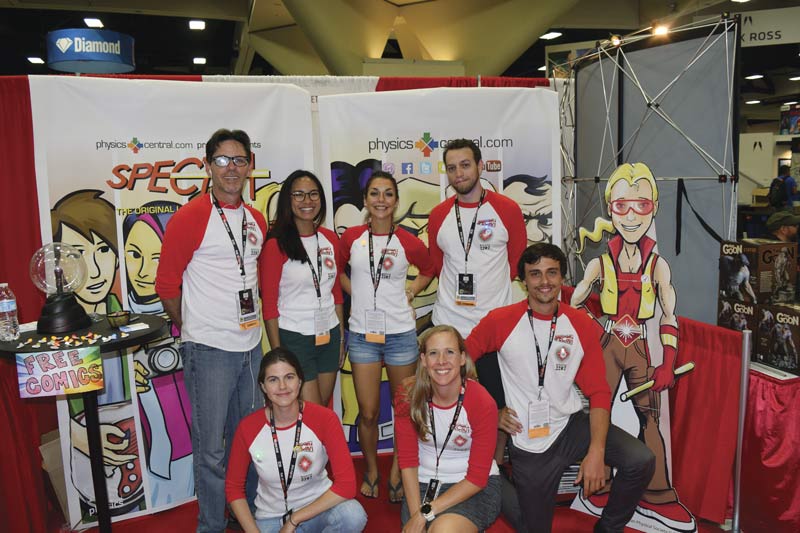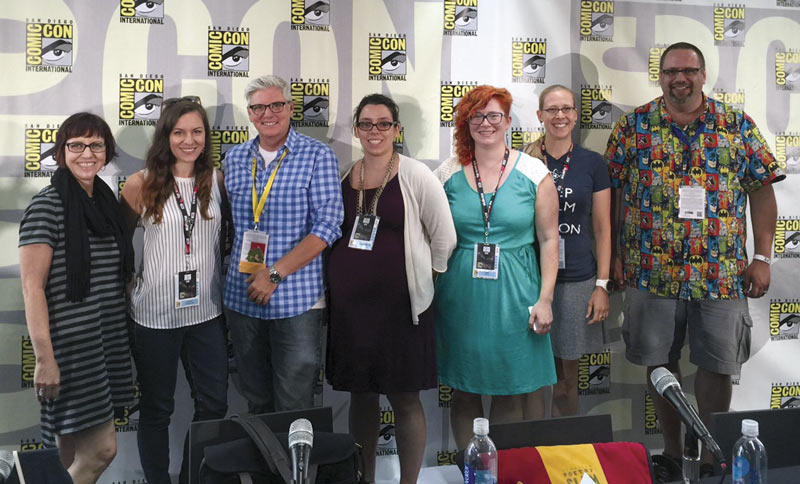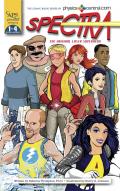Comic Book Physics: Enlightening Science for All
Fall
2016
Feature
Comic Book Physics: Enlightening Science for All
Rachel Kaufman, Contributing Writer

Faster than a speeding bullet (by a long shot), able to pass through transparent surfaces in a single instant—it's Spectra, the original laser superhero!
Spectra is a middle school girl with the powers of a laser. Created and written by Becky Thompson of the American Physical Society (APS) as part of the PhysicsQuest educational program, Spectra and her friends now star in seven adventures and counting.
Educational comics have been around in some form for years, but recently they have been gaining more acceptance; it’s into this tradition that the Spectra comics solidly fit. Spectra is a bit different, though, in that Thompson promotes the comics at teachers’ conventions and at mainstream comic events, like San Diego Comic-Con. Thompson just returned from her seventh year at the convention.
Thompson originally created Spectra as part of Laserfest, a celebration of the 50th anniversary of the first working laser. PhysicsQuest had dabbled in comics before, doing a biographical comic about Nikola Tesla, for example, but Spectra was APS’s first original character and first superhero.
The plot is pure old-school comics: “Lucy Hene [a mashup of the chemical symbols for helium and neon, of course] is a normal girl, and she develops, overnight, laser powers,” says Thompson. “All of her superpowers are things that lasers actually do.” So Lucy can pass through transparent surfaces, change colors depending on her energy level, even play CDs. In previous adventures she’s crossed paths with the Quantum Mechanic, General Relativity, Tiffany Maxwell (and her demon, of course), and the evil Miss Alignment and her henchmen.
“The goal is to get [kids] interested and excited about physics,” Thompson says. “They're not necessarily going to be able to walk away and ace a test on hydrodynamics, but they'll be able to use the words involved. They'll be more likely to try a bit of physics.”
To that end, it’s no coincidence that Spectra is a girl. “There’s a huge underrepresentation of women and minorities in physics,” Thompson says, as in comics. “One of the things I love seeing is the big sister who got dragged to this stupid thing with her brothers, and she sees this female superhero on the cover [of Spectra] and she's like, ‘Oh, wait, someone did this for me?’”
While both boys and girls seem to enjoy the comic, Thompson says she worked hard to make sure Spectra felt “welcoming to girls,” including spending a lot of time talking to the nonprofit Girl-Wonder.org, which is dedicated to positive representations of women in comics. “They said girls are really smart, and they know when they’re being marketed to. If you take a made-for-boys comic and put pink on it, they won’t read it.”

More importantly, of course, is this question: Are they actually learning? The answer appears to be yes. Kids are “just little sponges,” as Thompson says. “The amount they suck up from reading is amazing....We had one dad who was a physicist, brought the comics home from a conference, threw them down, and three days later his kid is coherently explaining lasers to him. The goal is not to have that happen but to allow that to happen.”
As APS publishes more and more Spectra adventures and kids learn more and more about physics, Thompson is also learning about the comic book world. She laughs when she recalls her first Comic-Con appearance seven years ago, something she was completely unprepared for. “I knew this would be a good way…to reach middle schoolers, but that was about it,” she said.
“We had no idea how many comics to bring—there are 125,000 people attending a day. The biggest conference I usually go to has 6,000 people,” she said. “So I printed a bunch. We have four pallets of comics, a team of six people, none of us know what we're doing, and [our booth faces] the DC Comics booth. They're installing the original Superman costumes, and here I am with a cardboard cutout.”
The Spectra booth gets bigger every year, though Thompson remains a bit awed by the entire thing. “We know what to expect and how we fit into it, but the fact that we even do fit into all of it is amazing. This is like the real comic book world. The fact that we’re not just there but we have people remember us—these are people that paid thousands of dollars to come here because they like comic books that much. It’s awesome that they’re taking the time to stop by and talk to us…It’s surprising how many people are not scientists but do appreciate that there is real science in comics.”
Spectra may have starred in seven comics so far, but it’s truly only the beginning. Her next adventure comes out this fall, in which the Terminal Twins star as the villains, and kids learn about electricity and magnetism. And there’s still Spectra’s origin story, which as of now is known only to Thompson, and a wide range of other physics that can be taught with the help of lasers. Basically, Thompson and her plucky superheroine are just getting started. //

